Hady Elsahar
Transferable Black-Box One-Shot Forging of Watermarks via Image Preference Models
Oct 23, 2025Abstract:Recent years have seen a surge in interest in digital content watermarking techniques, driven by the proliferation of generative models and increased legal pressure. With an ever-growing percentage of AI-generated content available online, watermarking plays an increasingly important role in ensuring content authenticity and attribution at scale. There have been many works assessing the robustness of watermarking to removal attacks, yet, watermark forging, the scenario when a watermark is stolen from genuine content and applied to malicious content, remains underexplored. In this work, we investigate watermark forging in the context of widely used post-hoc image watermarking. Our contributions are as follows. First, we introduce a preference model to assess whether an image is watermarked. The model is trained using a ranking loss on purely procedurally generated images without any need for real watermarks. Second, we demonstrate the model's capability to remove and forge watermarks by optimizing the input image through backpropagation. This technique requires only a single watermarked image and works without knowledge of the watermarking model, making our attack much simpler and more practical than attacks introduced in related work. Third, we evaluate our proposed method on a variety of post-hoc image watermarking models, demonstrating that our approach can effectively forge watermarks, questioning the security of current watermarking approaches. Our code and further resources are publicly available.
Geometric Image Synchronization with Deep Watermarking
Sep 18, 2025Abstract:Synchronization is the task of estimating and inverting geometric transformations (e.g., crop, rotation) applied to an image. This work introduces SyncSeal, a bespoke watermarking method for robust image synchronization, which can be applied on top of existing watermarking methods to enhance their robustness against geometric transformations. It relies on an embedder network that imperceptibly alters images and an extractor network that predicts the geometric transformation to which the image was subjected. Both networks are end-to-end trained to minimize the error between the predicted and ground-truth parameters of the transformation, combined with a discriminator to maintain high perceptual quality. We experimentally validate our method on a wide variety of geometric and valuemetric transformations, demonstrating its effectiveness in accurately synchronizing images. We further show that our synchronization can effectively upgrade existing watermarking methods to withstand geometric transformations to which they were previously vulnerable.
Video Seal: Open and Efficient Video Watermarking
Dec 12, 2024



Abstract:The proliferation of AI-generated content and sophisticated video editing tools has made it both important and challenging to moderate digital platforms. Video watermarking addresses these challenges by embedding imperceptible signals into videos, allowing for identification. However, the rare open tools and methods often fall short on efficiency, robustness, and flexibility. To reduce these gaps, this paper introduces Video Seal, a comprehensive framework for neural video watermarking and a competitive open-sourced model. Our approach jointly trains an embedder and an extractor, while ensuring the watermark robustness by applying transformations in-between, e.g., video codecs. This training is multistage and includes image pre-training, hybrid post-training and extractor fine-tuning. We also introduce temporal watermark propagation, a technique to convert any image watermarking model to an efficient video watermarking model without the need to watermark every high-resolution frame. We present experimental results demonstrating the effectiveness of the approach in terms of speed, imperceptibility, and robustness. Video Seal achieves higher robustness compared to strong baselines especially under challenging distortions combining geometric transformations and video compression. Additionally, we provide new insights such as the impact of video compression during training, and how to compare methods operating on different payloads. Contributions in this work - including the codebase, models, and a public demo - are open-sourced under permissive licenses to foster further research and development in the field.
Large Concept Models: Language Modeling in a Sentence Representation Space
Dec 11, 2024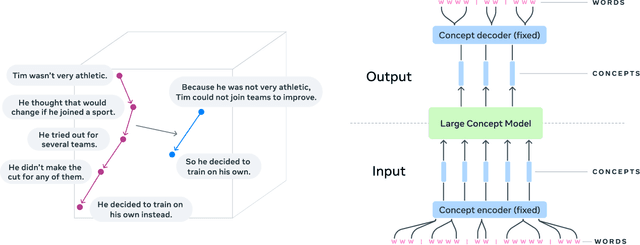

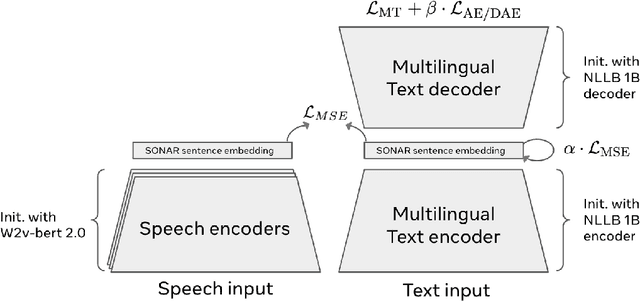
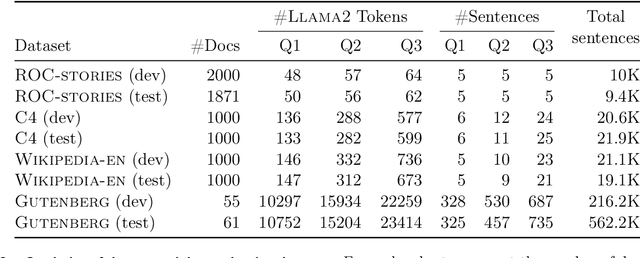
Abstract:LLMs have revolutionized the field of artificial intelligence and have emerged as the de-facto tool for many tasks. The current established technology of LLMs is to process input and generate output at the token level. This is in sharp contrast to humans who operate at multiple levels of abstraction, well beyond single words, to analyze information and to generate creative content. In this paper, we present an attempt at an architecture which operates on an explicit higher-level semantic representation, which we name a concept. Concepts are language- and modality-agnostic and represent a higher level idea or action in a flow. Hence, we build a "Large Concept Model". In this study, as proof of feasibility, we assume that a concept corresponds to a sentence, and use an existing sentence embedding space, SONAR, which supports up to 200 languages in both text and speech modalities. The Large Concept Model is trained to perform autoregressive sentence prediction in an embedding space. We explore multiple approaches, namely MSE regression, variants of diffusion-based generation, and models operating in a quantized SONAR space. These explorations are performed using 1.6B parameter models and training data in the order of 1.3T tokens. We then scale one architecture to a model size of 7B parameters and training data of about 2.7T tokens. We perform an experimental evaluation on several generative tasks, namely summarization and a new task of summary expansion. Finally, we show that our model exhibits impressive zero-shot generalization performance to many languages, outperforming existing LLMs of the same size. The training code of our models is freely available.
Proactive Detection of Voice Cloning with Localized Watermarking
Jan 30, 2024Abstract:In the rapidly evolving field of speech generative models, there is a pressing need to ensure audio authenticity against the risks of voice cloning. We present AudioSeal, the first audio watermarking technique designed specifically for localized detection of AI-generated speech. AudioSeal employs a generator/detector architecture trained jointly with a localization loss to enable localized watermark detection up to the sample level, and a novel perceptual loss inspired by auditory masking, that enables AudioSeal to achieve better imperceptibility. AudioSeal achieves state-of-the-art performance in terms of robustness to real life audio manipulations and imperceptibility based on automatic and human evaluation metrics. Additionally, AudioSeal is designed with a fast, single-pass detector, that significantly surpasses existing models in speed - achieving detection up to two orders of magnitude faster, making it ideal for large-scale and real-time applications.
Seamless: Multilingual Expressive and Streaming Speech Translation
Dec 08, 2023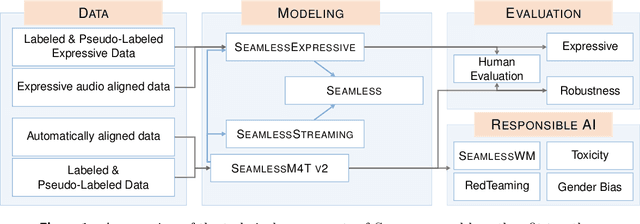
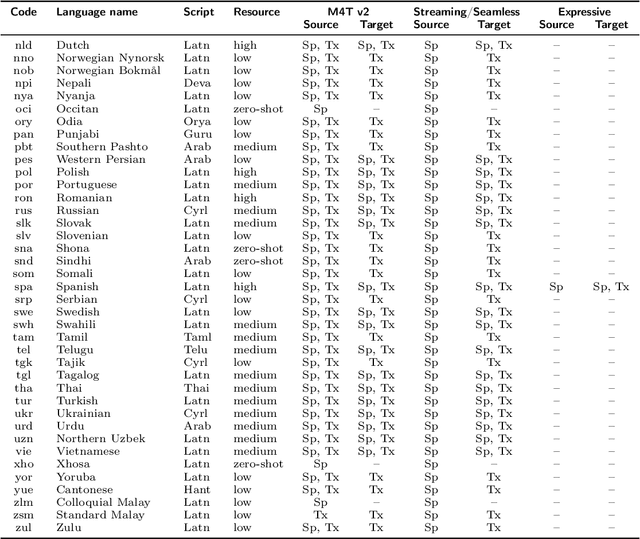

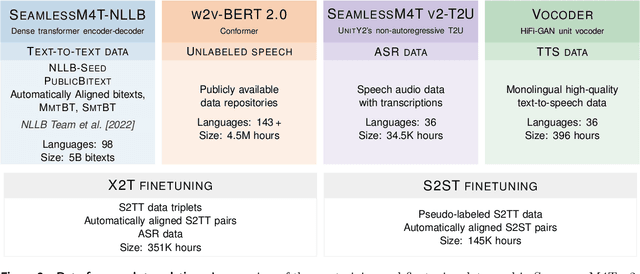
Abstract:Large-scale automatic speech translation systems today lack key features that help machine-mediated communication feel seamless when compared to human-to-human dialogue. In this work, we introduce a family of models that enable end-to-end expressive and multilingual translations in a streaming fashion. First, we contribute an improved version of the massively multilingual and multimodal SeamlessM4T model-SeamlessM4T v2. This newer model, incorporating an updated UnitY2 framework, was trained on more low-resource language data. SeamlessM4T v2 provides the foundation on which our next two models are initiated. SeamlessExpressive enables translation that preserves vocal styles and prosody. Compared to previous efforts in expressive speech research, our work addresses certain underexplored aspects of prosody, such as speech rate and pauses, while also preserving the style of one's voice. As for SeamlessStreaming, our model leverages the Efficient Monotonic Multihead Attention mechanism to generate low-latency target translations without waiting for complete source utterances. As the first of its kind, SeamlessStreaming enables simultaneous speech-to-speech/text translation for multiple source and target languages. To ensure that our models can be used safely and responsibly, we implemented the first known red-teaming effort for multimodal machine translation, a system for the detection and mitigation of added toxicity, a systematic evaluation of gender bias, and an inaudible localized watermarking mechanism designed to dampen the impact of deepfakes. Consequently, we bring major components from SeamlessExpressive and SeamlessStreaming together to form Seamless, the first publicly available system that unlocks expressive cross-lingual communication in real-time. The contributions to this work are publicly released and accessible at https://github.com/facebookresearch/seamless_communication
SeamlessM4T-Massively Multilingual & Multimodal Machine Translation
Aug 23, 2023
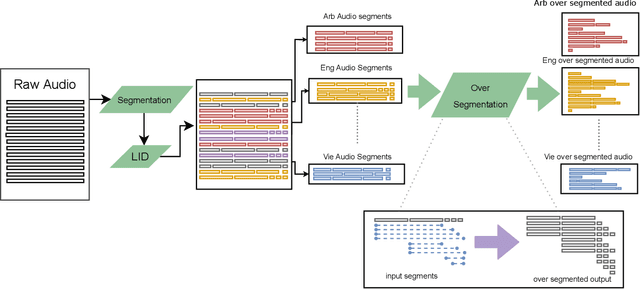
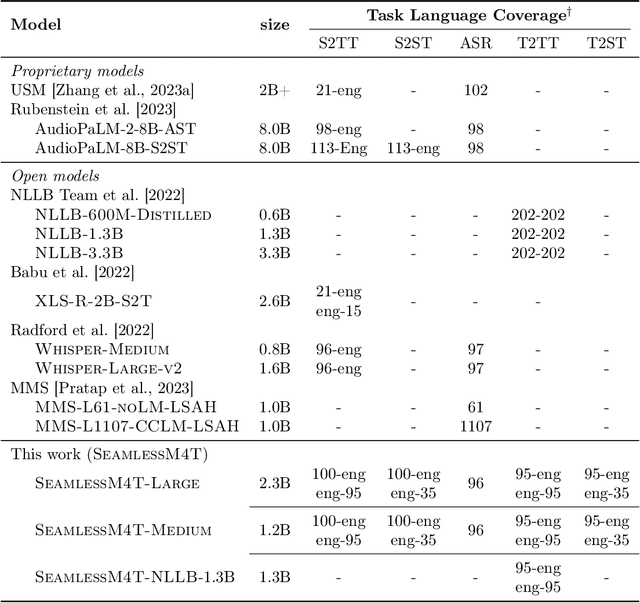
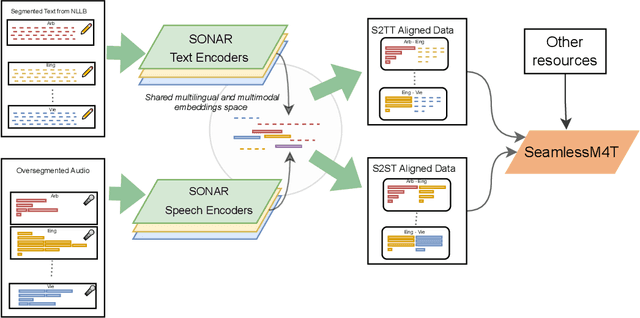
Abstract:What does it take to create the Babel Fish, a tool that can help individuals translate speech between any two languages? While recent breakthroughs in text-based models have pushed machine translation coverage beyond 200 languages, unified speech-to-speech translation models have yet to achieve similar strides. More specifically, conventional speech-to-speech translation systems rely on cascaded systems that perform translation progressively, putting high-performing unified systems out of reach. To address these gaps, we introduce SeamlessM4T, a single model that supports speech-to-speech translation, speech-to-text translation, text-to-speech translation, text-to-text translation, and automatic speech recognition for up to 100 languages. To build this, we used 1 million hours of open speech audio data to learn self-supervised speech representations with w2v-BERT 2.0. Subsequently, we created a multimodal corpus of automatically aligned speech translations. Filtered and combined with human-labeled and pseudo-labeled data, we developed the first multilingual system capable of translating from and into English for both speech and text. On FLEURS, SeamlessM4T sets a new standard for translations into multiple target languages, achieving an improvement of 20% BLEU over the previous SOTA in direct speech-to-text translation. Compared to strong cascaded models, SeamlessM4T improves the quality of into-English translation by 1.3 BLEU points in speech-to-text and by 2.6 ASR-BLEU points in speech-to-speech. Tested for robustness, our system performs better against background noises and speaker variations in speech-to-text tasks compared to the current SOTA model. Critically, we evaluated SeamlessM4T on gender bias and added toxicity to assess translation safety. Finally, all contributions in this work are open-sourced and accessible at https://github.com/facebookresearch/seamless_communication
BLOOM: A 176B-Parameter Open-Access Multilingual Language Model
Nov 09, 2022Abstract:Large language models (LLMs) have been shown to be able to perform new tasks based on a few demonstrations or natural language instructions. While these capabilities have led to widespread adoption, most LLMs are developed by resource-rich organizations and are frequently kept from the public. As a step towards democratizing this powerful technology, we present BLOOM, a 176B-parameter open-access language model designed and built thanks to a collaboration of hundreds of researchers. BLOOM is a decoder-only Transformer language model that was trained on the ROOTS corpus, a dataset comprising hundreds of sources in 46 natural and 13 programming languages (59 in total). We find that BLOOM achieves competitive performance on a wide variety of benchmarks, with stronger results after undergoing multitask prompted finetuning. To facilitate future research and applications using LLMs, we publicly release our models and code under the Responsible AI License.
What Language Model to Train if You Have One Million GPU Hours?
Nov 08, 2022



Abstract:The crystallization of modeling methods around the Transformer architecture has been a boon for practitioners. Simple, well-motivated architectural variations can transfer across tasks and scale, increasing the impact of modeling research. However, with the emergence of state-of-the-art 100B+ parameters models, large language models are increasingly expensive to accurately design and train. Notably, it can be difficult to evaluate how modeling decisions may impact emergent capabilities, given that these capabilities arise mainly from sheer scale alone. In the process of building BLOOM--the Big Science Large Open-science Open-access Multilingual language model--our goal is to identify an architecture and training setup that makes the best use of our 1,000,000 A100-GPU-hours budget. Specifically, we perform an ablation study at the billion-parameter scale comparing different modeling practices and their impact on zero-shot generalization. In addition, we study the impact of various popular pre-training corpora on zero-shot generalization. We also study the performance of a multilingual model and how it compares to the English-only one. Finally, we consider the scaling behaviour of Transformers to choose the target model size, shape, and training setup. All our models and code are open-sourced at https://huggingface.co/bigscience .
On Reinforcement Learning and Distribution Matching for Fine-Tuning Language Models with no Catastrophic Forgetting
Jun 01, 2022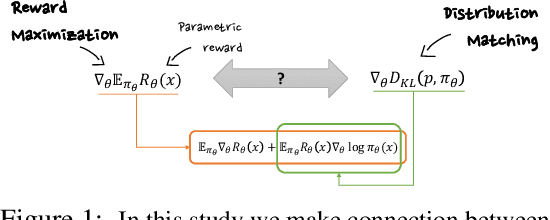

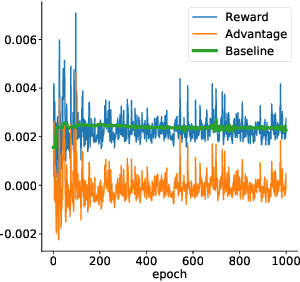
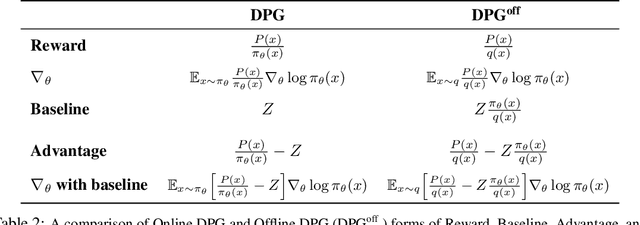
Abstract:The availability of large pre-trained models is changing the landscape of Machine Learning research and practice, moving from a training-from-scratch to a fine-tuning paradigm. While in some applications the goal is to "nudge" the pre-trained distribution towards preferred outputs, in others it is to steer it towards a different distribution over the sample space. Two main paradigms have emerged to tackle this challenge: Reward Maximization (RM) and, more recently, Distribution Matching (DM). RM applies standard Reinforcement Learning (RL) techniques, such as Policy Gradients, to gradually increase the reward signal. DM prescribes to first make explicit the target distribution that the model is fine-tuned to approximate. Here we explore the theoretical connections between the two paradigms, and show that methods such as KL-control developed for RM can also be construed as belonging to DM. We further observe that while DM differs from RM, it can suffer from similar training difficulties, such as high gradient variance. We leverage connections between the two paradigms to import the concept of baseline into DM methods. We empirically validate the benefits of adding a baseline on an array of controllable language generation tasks such as constraining topic, sentiment, and gender distributions in texts sampled from a language model. We observe superior performance in terms of constraint satisfaction, stability and sample efficiency.
 Add to Chrome
Add to Chrome Add to Firefox
Add to Firefox Add to Edge
Add to Edge